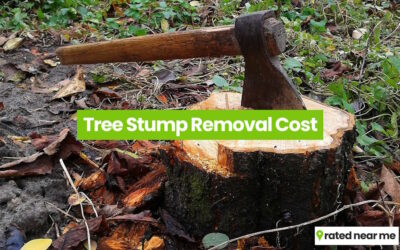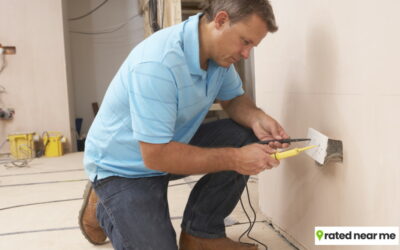Scaffolding towers can be an affordable and versatile alternative to traditional scaffolding. But what is the cost of scaffold tower hire? And what else should you know before you rent a scaffolding tower?
Access to high areas is often an essential part of any commercial construction project. However, a surprising number of home maintenance projects also require working at height. In these instances, a scaffold tower is an incredibly popular choice to facilitate access.
Whether you are a contractor or an individual – this guide will:
- Summarise the key advantages & features of scaffolding towers
- Detail scaffolding tower hire costs
- Explain the rules and regulations that you need to be aware of when hiring a scaffold tower
What is a scaffold tower?
A scaffold tower is a free-standing mobile access tower that allows individuals or small groups of people to work safely at height.
Scaffolding towers closely resemble traditional scaffolding. Interconnecting metal poles make up the four sides of the tower, and also provide internal bridges between each side for structural support.
At the top of the structure sits a simple working platform with guardrails to prevent falls. Safe access to the platform is usually made via a built-in ladder on the side of the tower.
At the bottom of the structure, the tower sits on four wheels to make it easy to move from one location to another.
Stabilizing poles – or “outriggers” – may also be used to ensure the tower does not move once erected.
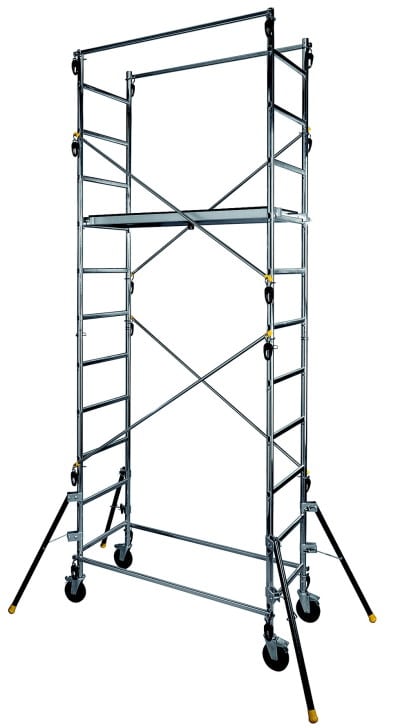
Common Uses For A Scaffolding Tower
Scaffolding towers are generally used for smaller, shorter projects undertaken by an individual or small group of contractors. They can be fantastic solutions for jobs such as painting home exteriors, window repair and maintenance, and are even used as camera towers at festivals and sporting events.
Scaffold towers are less suitable for larger projects which require a more significant workforce. This is because they can only reach one area at a time – and are generally not designed to support the weight of a large group of workers and their equipment.
What is the maximum height of a scaffold tower?
Scaffolding towers can be built to a height of up to 8 metres in outdoor environments and 12 metres in indoor environments.
What are the advantages of a scaffold tower?
From convenience to cost – there are a number of reasons why tower scaffold is a popular access solution among tradesmen and homeowners alike:
Work In Comfort
Scaffolding towers make it easy to work at height for extended periods of time. The scaffold platform gives you ample room to kneel or stand – and you can also keep essential tools right by your side. Unlike when using a ladder, you can also use both hands while you work (this is because one hand should always be holding a ladder when in use).
Quick & Easy Construction
It’s essential that a scaffold tower is constructed safely (more on that below) and according to the manufacturer’s instructions. However, a scaffold tower is nonetheless straightforward to assemble – and some can even be assembled by one individual. A moderate sized tower can be erected in under 10 minutes.
This is a sharp contrast to traditional scaffolding, which can be incredibly labour intensive and time-consuming to erect – even for groups of people. That is why the cost of hiring traditional scaffolding is often very expensive.
Cost vs Traditional Scaffolding Hire
A scaffold tower is almost always significantly cheaper than traditional scaffolding costs. Hire costs can be as low as £30-40 per week for a basic tower, compared to £300-600 for traditional scaffolding.
Mobility
Thanks to the four wheels at the base of the tower, scaffold towers can be easily moved from place to place or around the circumference of a building.
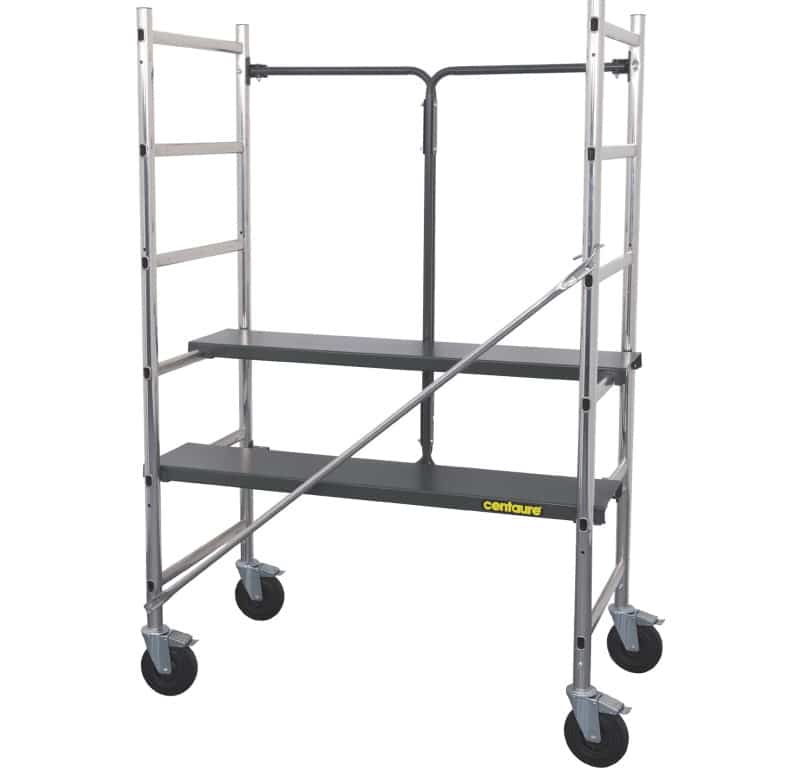
What are the disadvantages of a scaffold tower?
Despite their obvious advantages, there are also some important considerations to take into account when deciding whether a scaffold tower is right for your project.
Scaffold Towers Require Suitable Terrain
The wheels on a scaffold tower can be adjusted to help it to remain level on different surfaces. Nevertheless, a scaffold tower requires a firm, flat surface in order to be used safely. A sloped driveway, uneven patio or a mix of surfaces (for example gravel and grass) may prevent a scaffold tower being erected safely.
Not Suitable For Windy Conditions
Being a lighter, temporary structure – scaffold towers cannot be used in windy conditions. Industry body PASMA advises that, if wind speeds reach 17mph , work should stop and the tower should be dismantled. While there is no specific regulation for working on traditional scaffolding in high winds, the structure itself can remain erected in all conditions.
Susceptible To Wear & Tear
Scaffold towers are designed to be lightweight, easy to construct and effortless to move around. However, the lighter materials that enable these benefits can be susceptible to wear and tear over time – with potentially dangerous consequences. Extra care should be taken to inspect the condition of the tower components prior to construction.
Scaffold Tower Hire Guide
With a vast range of scaffold tower hire companies and different models to choose from, the choice can be overwhelming! To help you choose, here are the key considerations to keep in mind when hiring a scaffold tower:
Height And Size
It may sound obvious – but it’s vital that you determine the correct tower height for your project.
It can be dangerous to try and build a scaffold tower higher than what is stipulated by the manufacturer.
Scaffold towers can be built up to 8 metres high outdoors and 12 metres high indoors. Tower heights are usually customisable at 1 metre intervals up to these levels.
The scaffold platform is what you will stand on when carrying out the work.
Scaffold platform width is typically between 0.85m and 1.45m. Scaffold platform length is typically between 1.8m and 2.5m.
You should also consider how many platforms you want your tower to have.
If you need continual access to different heights as part of your project, it’s possible to hire scaffolding towers with multiple platforms.
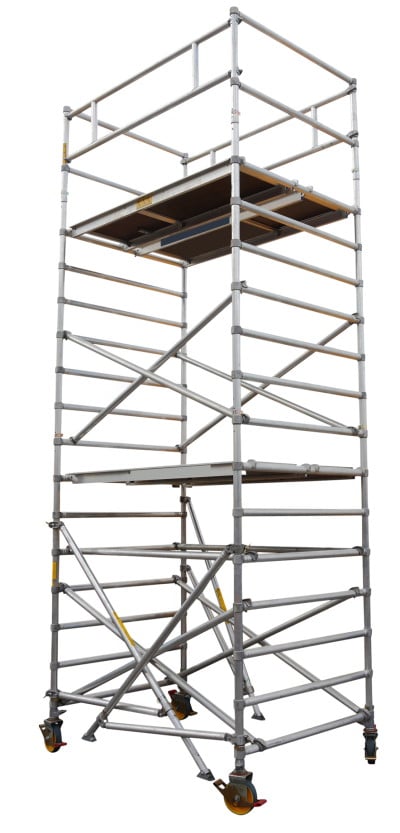
Materials And Weight
For the best DIY scaffold tower – Aluminium is the most popular choice of material. Aluminium is lightweight and inexpensive, which means that aluminium tower scaffold is cheap to rent, easy to construct and effortless to move around.
Fibreglass is the material of choice for those who need a tower with non-conductive properties when working with electricity. However, for the majority of non-commercial uses, a fibreglass access tower is comparatively heavy, expensive and easily damaged.
Inexpensive Steel scaffold towers are the most durable option. Steel offers greater resistance to weather than aluminum and can also support heavier loads (or more tower users). However, the weight of the steel components is prohibitive when it comes to storing, transporting and constructing the tower.
For the majority of homeowners, or those looking for one man scaffold tower hire, aluminum is the best choice of material.
Safety
All scaffolding towers should be thoroughly inspected prior to their use. However, for added peace of mind you may choose to look for a EN1004 or BS EN1005 access tower.
Towers that conform to this standard have demonstrated that they meet minimum safety requirements. These include built-in safe access (usually a built-in ladder), purpose-built platforms and a sufficient number of guardrails and stabilizers.
Scaffolding Tower Hire Costs
Typically, the cost of scaffold tower hire is agreed on a weekly basis – although you may be able to rent scaffolding towers from a local supplier for a shorter period of time.
The hire guide above describes a range of variables that you should consider when choosing a scaffold tower for hire. It should come as no surprise that the choices you make can have a significant impact on scaffolding hire costs. However, the following prices represent ballpark figures from which you can compare quotes:
Small access towers – Up to 2m – Around £45 per week
Medium access towers – Up to 5m – Around £90 per week
Large access towers – Up to 10m – Around £160 per week
To find local scaffold providers and compare quotes in minutes – you can use our quick and easy tower scaffolding companies quote tool to compare prices.
Can anyone hire a scaffold tower?
There are no specific safety standards / restrictions that prevent you from hiring a scaffold tower. However, there are some regulations that you should be aware of.
If you are employed or self-employed, use of a scaffold tower in the workplace falls under the UK government’s Work at Height regulations.
If you are using a scaffold tower in a personal capacity, the regulations do not apply to you. Nevertheless, it is worth understanding the regulations to help you use a tower safely.
The key considerations of the Work at Height regulations are:
Risk Assessment – You should carry out a thorough risk assessment prior to erecting the tower.
Competency – The person using or supervising the use of the tower must be competent in inspecting, building, using and dismantling the scaffold tower.
Inspection – The tower and its components should be regularly inspected to ensure they continue to be safe to use.
For those using a scaffold tower in a personal capacity, these key considerations can be broken down into the following best practices:
- Carry out your own risk assessment: Check that the surface you wish to erect a tower on is even. Ensure that there are no power lines or overhead cables which may impede safe use. Do not erect the tower in hazardous weather conditions
- Choose a suitable tower for your needs – and do not build the platform height higher than is recommended by the manufacturer
- Check the components of the tower for signs of wear & tear, or damage
- Closely follow the manufacturer’s instructions when assembling and dismantling the tower
- If you need to move the tower, dismantle the tower to a height of no more than 4 metres
- You and anyone using the tower should take regular breaks
Scaffold tower or a ladder – which should I use?
An obvious alternative to scaffold tower hire is hiring a ladder. The suitability of using a ladder for a specific job depends on the length of time that you envisage using the ladder for.
Some jobs only require working at height for a short period of time – for example putting up outdoor Christmas lights or cleaning a gutter. In these instances, a ladder is a practical and inexpensive option to get the job done.
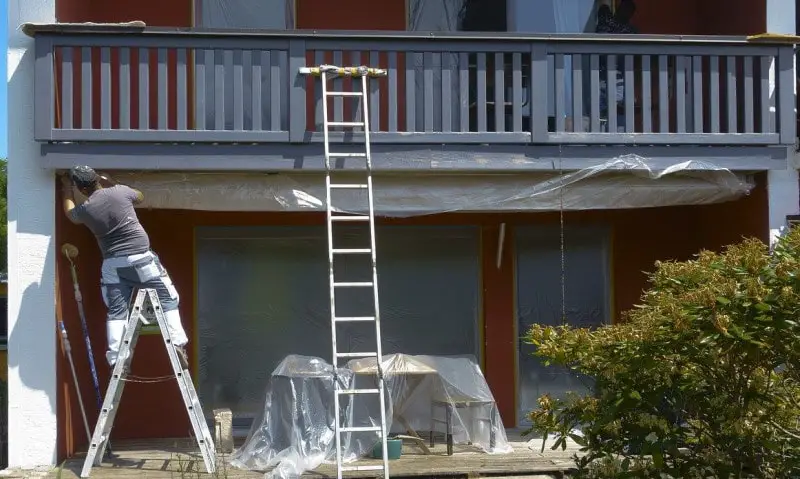
However, some jobs such as painting or more significant gutter maintenance, may require you to work at height for extended periods of time.
In these instances, a scaffold tower makes it more convenient and significantly safer to work for longer – and gives you the freedom of using both hands. Tools and materials can also be kept by your side on the raised platform.

Scaffold tower or cherry picker – which should I use?
Despite its name, a Cherry Picker (or Spider Lift) is a viable access method for many instances where you might need to work at height.
They are most commonly used in a commercial setting where they can reach heights of up to 75m. However smaller models are also available, which are more suitable for home use.
Cherry pickers are advantageous because both you and your equipment can be quickly and easily lifted to a height – and back down again.
However, a cherry picker is not usually seen as a “DIY” solution. Many are rented with an operator, who will drive the equipment to your home and ensure that it is used safely.
This means that cherry pickers can cost in the region of £50 per hour to hire.
If you need to access a hard-to-reach area for a small amount of time, a cherry picker with an operator can be an incredibly convenient option.
For longer projects, a scaffolding tower is a much cheaper option – and hire is likely to be more flexible if you need it for longer than you anticipated.
Scaffolding Hire Near Me
We hope that this guide has armed you with all the knowledge that you need to hire the right scaffolding tower for your project. The next step is to find scaffold hire services local to you – and start comparing quotes!
You can use Rated Near Me to find highly rated services near you – absolutely free!
Compare scaffolding costs for free from highly rated scaffolding hire companies in your area today.
Please Share
If you liked this free guide, please share it with your friends and colleagues


